Bristol Beaufighter
| Type 156 Beaufighter | |
|---|---|

| |
| The Beaufighter Mk X with rockets. This machine is NE255/EE-H of No. 404 Squadron RCAF, of RAF Coastal Command at Davidstow Moor, 21 August 1944.[1] | |
| Role | Heavy fighter / strike aircraft |
| Manufacturer | Bristol Aeroplane Company |
| First flight | 17 July 1939 |
| Introduction | 27 July 1940 |
| Retired | 1960 (Australia) |
| Primary users | Royal Air Force Royal Canadian Air Force Royal Australian Air Force |
| Produced | May 1940 – 1946 |
| Number built | 5,928 |
| Developed from | Bristol Beaufort |
The Bristol Type 156 Beaufighter (often referred to simply as the "Beau") is a multi-role aircraft developed during the Second World War by Bristol Aeroplane Company in the UK. It was originally conceived as a heavy fighter variant of the Bristol Beaufort bomber. The Beaufighter was a versatile aircraft used in service initially as a night fighter, and later mainly in the maritime strike and ground attack roles; it also replaced the earlier Beaufort as a torpedo bomber.
Variants built in Australia by the Department of Aircraft Production (DAP) were sometimes referred to by the name DAP Beaufighter.
Design and development

The idea of a fighter development of the Beaufort was suggested to the Air Ministry by Bristol. The suggestion coincided with the delays in the development and production of the Westland Whirlwind cannon-armed twin-engine fighter.[2] Bristol made proposals of a fixed four-cannon version and a turret fighter with twin cannons; the former was preferred by the assistant chief of the air staff. As a torpedo bomber and "general reconnaissance" aircraft the Beaufort had moderate performance but for fighter-like performance Bristol suggested their new Hercules engines in place of the Beaufort's Taurus (another Bristol engine).
Since the "Beaufort cannon fighter" was a conversion of an existing design, development and production was expected far more quickly than with a completely fresh design. Accordingly, the air ministry produced draft Specification F.11/37 written around Bristol's suggestion for an "interim" aircraft pending proper introduction of the Whirlwind. Bristol started building a prototype by taking a partly-built Beaufort out of the production line. This conversion served to speed the process—Bristol had promised series production in early 1940 on the basis of an order being placed in February 1939—and the ministry ordered two prototypes from the line and two built from scratch. Although it had been expected that maximum re-use of Beaufort components would speed the process, the fuselage needed more work than expected and had to be completely redesigned.[3] As such, the first prototype flew for the first time on 17 July 1939, a little more than eight months after the design had started, possibly due to the use of much of the Beaufort's design and parts. A production contract for 300 machines "off the drawing board" had already been placed two weeks before the prototype F.17/39 even flew.

The first prototype achieved 335 mph (539 km/h) at 16,800 ft (5,120 m), the second prototype[4] when laden with operational equipment was slower at 309 mph at 15,000 ft. Large orders were placed at the start of the Second World War but this meant an expected shortage of Hercules engines. In February 1940, conversion of three aircraft to Rolls-Royce Merlins was ordered; success with the design was expected to lead to production aircraft in 1941. The Merlin engine installations and nacelles were designed for the Beaufighter by Rolls-Royce as a complete "power egg" unit. The first Merlin powered aircraft flew in June 1940. The Beaufighter Merlin installation was later incorporated into the design for what became the Avro Lancaster. However it was found that the Merlins left the Beaufighter underpowered and gave it a pronounced tendency to swing to port, making take-offs and landings difficult and resulting in a high accident rate — out of 337 Merlin-powered aircraft, 102 were lost to accidents.[5] Due to wartime shortages, some Beaufighters were placed into operational service without equipment necessary to feather the propellers. As some models of the twin-engined Beaufighter could not stay aloft on one engine unless the dead propeller was feathered, the lack of feathering equipment caused operational losses and deaths of aircrew.[6]

The Bristol Taurus engines of the Beaufort were not powerful enough for a fighter and were replaced by more powerful Bristol Hercules engines. The extra power presented problems with vibration; in the final design they were mounted on longer, more flexible, struts, which extended from the front of the wings. This moved the centre of gravity (CoG) forward, an undesirable feature in aircraft design. It was moved back by shortening the nose, as no space was needed for a bomb aimer in a fighter. This put most of the fuselage behind the wing, and restored the CoG to its proper location. With the engine cowlings and propellers now further forward than the tip of the nose, the Beaufighter had a characteristically stubby appearance.
In general — apart from powerplants — the differences between the Beaufort and Beaufighter were minor. The wings, control surfaces, retractable landing gear and aft section of the fuselage were identical to those of the Beaufort, while the wing centre section was similar apart from certain fittings. The bomb bay was omitted, and four forward-firing 20 mm Hispano Mk III cannons were mounted in the lower fuselage area. These were initially fed from 60-round drums, requiring the radar operator to change the ammunition drums manually—an arduous and unpopular task, especially at night and while chasing a bomber. As a result, they were soon replaced by a belt-feed system. The cannons were supplemented by six .303 in (7.7 mm) Browning machine guns in the wings (four starboard, two port, the asymmetry caused by the port mounting of the landing light).[7] This was one of the heavier, if not the heaviest, fighter armament of its time.[8][9] When Beaufighters were developed as fighter-torpedo bombers, they used their firepower (often the machine guns were removed) to suppress flak fire and hit enemy ships, especially escorts and small vessels. The recoil of the cannons and machine guns could reduce the speed of the aircraft by around 25 knots when they fired.[10]
The areas for the rear gunner and bomb-aimer were removed, leaving only the pilot in a fighter-type cockpit. The navigator-radar operator sat to the rear under a small Perspex bubble where the Beaufort's dorsal turret had been. Both crew-members had their own hatch in the floor of the aircraft. The front hatch was behind the pilot's seat. As there was no room to climb around the seat-back, the back collapsed to allow the pilot to climb over and into the seat. In an emergency, the pilot would operate a lever that remotely released the hatch, grasp two steel overhead tubes and lift himself out of his seat, swing his legs over the open hatchway, then let go to drop through. Evacuating the aircraft was easier for the navigator as the rear hatch was in front of him and without obstruction.[11]
Production of the Beaufort in Australia, and the highly successful use of British-made Beaufighters by the Royal Australian Air Force, led to Beaufighters being built by the Australian Department of Aircraft Production (DAP) from 1944 onwards. The DAP's variant was an attack and torpedo bomber known as the "Mark 21": design changes included Hercules VII or XVIII engines and some minor changes in armament.
By the time British production lines shut down in September 1945, 5,564 Beaufighters had been built in Britain by Bristol and also by the Fairey Aviation Company at Stockport and RAF Ringway (498); also by the Ministry of Aircraft Production (3336) and Rootes at Speke (260).
When Australian production ceased in 1946, 365 Mk.21s had been built.[12][13]
Operational service

By fighter standards, the Beaufighter Mk.I was rather heavy and slow. It had an all-up weight of 16,000 lb (7,000 kg) and a maximum speed of only 335 mph (540 km/h) at 16,800 ft (5,000 m). Nevertheless, this was all that was available at the time in Great Britain, as further production of the Westland Whirlwind had already been stopped due to problems with production of its Rolls-Royce Peregrine engines.
The first Beaufighter was delivered to RAF Tangmere for trials with the Fighter Interception Unit on 12 August 1940, and the first operational machines were received by 29 Squadron and 604 Squadron on 2 September.[14]
The Beaufighter came off the production line at almost exactly the same time as the first British airborne interception night fighter radar sets. With the four 20 mm cannons mounted in the lower fuselage, the nose could accommodate the radar antennas, and while early airborne interception equipment was too bulky to fit in single-engine fighters of the day, this was not a problem with the spacious fuselage of the Beaufighter. Even loaded to 20,000 lb (9,100 kg) the aircraft was fast enough to catch German bombers. By early 1941, it was an effective counter to Luftwaffe night raids. The various early models of the Beaufighter soon commenced service overseas, where its ruggedness and reliability quickly made the aircraft popular with crews although it was heavy on the controls and not easy to fly, good landings being a particular challenge.[15]
A night-fighter Mk VIF was supplied to squadrons in March 1942, equipped with AI Mark VIII radar. As the faster de Havilland Mosquito took over in the night fighter role in mid to late 1942, the heavier Beaufighter made valuable contributions in other areas such as anti-shipping, ground attack and long-range interdiction, in every major theatre of operations.
In the Mediterranean, the USAAF's 414th, 415th, 416th and 417th night fighter squadrons received 100 Beaufighters in the summer of 1943, achieving their first victory in July 1943. Through the summer the squadrons conducted both daytime convoy escort and ground-attack operations, but primarily flew defensive interception missions at night. Although the Northrop P-61 Black Widow fighter began to arrive in December 1944, USAAF Beaufighters continued to fly night operations in Italy and France until late in the war.
By the autumn of 1943, the Mosquito was available in enough numbers to replace the Beaufighter as the primary night fighter of the RAF. By the end of the war some seventy pilots serving with RAF units had become aces while flying Beaufighters.
At least one captured Beaufighter was operated by the Luftwaffe – a photograph exists of the aircraft in flight, with German markings.[16]
Coastal command
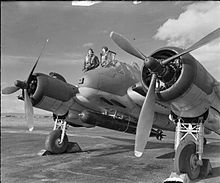
1941 saw the development of the Beaufighter Mk.IC long-range heavy fighter. This new variant entered service in May 1941 with a detachment from No. 252 Squadron operating from Malta. The aircraft proved so effective in the Mediterranean against shipping, aircraft and ground targets that coastal command became the major user of the Beaufighter, replacing the now obsolete Beaufort and Blenheim.
Coastal command began to take delivery of the up-rated Mk.VIC in mid-1942. By the end of 1942, Mk VICs were being equipped with torpedo-carrying gear, enabling them to carry the British 18 in (450 mm) or the US 22.5 in (572 mm) torpedo externally. Observers were not happy about carrying the torpedo as they were unable to use the escape hatch until the torpedo was dropped. The first successful torpedo attacks by Beaufighters came in April 1943, with No. 254 Squadron sinking two merchant ships off Norway.

The Hercules Mk XVII, developing 1,735 hp (1,294 kW) at 500 ft (150 m), was installed in the Mk VIC airframe to produce the TF Mk.X (torpedo fighter), commonly known as the "Torbeau". The Mk X became the main production mark of the Beaufighter. The strike variant of the Torbeau was designated the Mk.XIC. Beaufighter TF Xs would make precision attacks on shipping at wave-top height with torpedoes or "60lb" RP-3 rockets. Early models of the Mk Xs carried centimetric-wavelength ASV (air-to-surface vessel) radar with "herringbone" antennae carried on the nose and outer wings, but this was replaced in late 1943 by the centimetric AI Mark VIII radar housed in a "thimble-nose" radome, enabling all-weather and night attacks.
The North Coates Strike Wing of coastal command, based at RAF North Coates on the Lincolnshire coast, developed tactics which combined large formations of Beaufighters using cannons and rockets to suppress flak while the Torbeaus attacked at low level with torpedoes. These tactics were put into practice in mid-1943, and in a 10 month period, 29,762 tons (84,226 m3) of shipping were sunk. Tactics were further adapted when shipping was moved from port during the night. North Coates Strike Wing operated as the largest anti-shipping force of the Second World War, and accounted for over 150,000 tons (424,500 m3) of shipping and 117 vessels for a loss of 120 Beaufighters and 241 aircrew killed or missing. This was half the total tonnage sunk by all strike wings between 1942 and 1945.
Pacific war
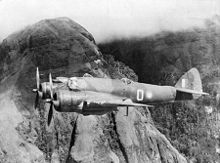
The Beaufighter arrived at squadrons in Asia and the Pacific in mid-1942. It has often been said—although it was originally a piece of RAF whimsy quickly taken up by a British journalist—that Japanese soldiers referred to the Beaufighter as "whispering death", supposedly because attacking aircraft often were not heard (or seen) until it was too late.[17] The Beaufighter's Hercules engines used sleeve valves which lacked the noisy valve gear common to poppet valve engines. This was most apparent in a reduced noise level at the front of the engine.
Southeast Asia
In the South-East Asian Theatre, the Beaufighter Mk VIF operated from India as a night fighter and on operations against Japanese lines of communication in Burma and Thailand. Mark X Beaufighters were also flown on long range daylight intruder missions over Burma. The high-speed, low-level attacks were very effective, despite often atrocious weather conditions, and makeshift repair and maintenance facilities.[18]
Southwest Pacific
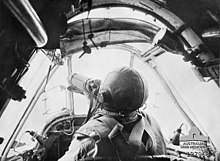
Before DAP Beaufighters arrived at Royal Australian Air Force units in the South West Pacific Theatre, the Bristol Beaufighter Mk IC was employed in anti-shipping missions.
The most famous of these was the Battle of the Bismarck Sea, where they were used in a fire-suppression role in a mixed force with USAAF Douglas A-20 Boston and North American B-25 Mitchell bombers.
The No. 30 Squadron RAAF Beaufighters flew in at mast height to provide heavy suppressive fire for the waves of attacking bombers. The Japanese convoy, under the impression that they were under torpedo attack, made the tactical error of turning their ships towards the Beaufighters, which inflicted severe damage on the ships' anti-aircraft guns, bridges and crews during strafing runs with their four 20 mm nose cannons and six wing-mounted .303 in (7.7 mm) machine guns. The Japanese ships were left exposed to mast-height bombing and skip bombing attacks by the US medium bombers. Eight transports and four destroyers were sunk for the loss of five aircraft, including one Beaufighter. The role of the Beaufighters was recorded by the war correspondent and film-maker, Damien Parer, who flew standing behind the pilot of one of the No. 30 Squadron aircraft.[10]
Postwar
From late 1944, RAF Beaufighter units were engaged in the Greek Civil War, finally withdrawing in 1946.
The Beaufighter was also used by the air forces of Portugal, Turkey and the Dominican Republic. It was used briefly by the Israeli Air Force after some ex-RAF examples were clandestinely purchased in 1948.
Many Mark 10 aircraft were converted to the target tug role postwar as the TT.10 and served with several RAF support units until 1960. The last flight of a Beaufighter in RAF service was by TT.10 RD761 from RAF Seletar on 12 May 1960.[19]
Variants
- Beaufighter Mk IF
- Two-seat night fighter variant
- Beaufighter Mk IC
- The "C" stood for coastal command variant; many were modified to carry bombs
- Beaufighter Mk IIF
- however well the Beaufighter performed, the Short Stirling bomber programme by late 1941 had a higher priority for the Hercules engine, and the Rolls-Royce Merlin XX-powered Mk IIF night fighter was the result
- Beaufighter Mk III/IV
- The Mark III and Mark IV were to be Hercules and Merlin powered Beaufighters with a new, slimmer fuselage, carrying an armament of six cannons and six machine guns that would give performance improvements. The necessary costs of making the changes to the production line led to the curtailing of the marks.[20]
- Beaufighter Mk V
- the Vs had a Boulton Paul turret with four 0.303 in (7.7 mm) machine guns mounted aft of the cockpit supplanting one pair of cannons and the wing-mounted machine guns. Only two (Merlin-engined) Mk Vs were built. When tested by the A&AEE, R2274 was capable of 302 mph at 19,000 ft.[21]
- Beaufighter Mk VI
- the Hercules returned with the next major version in 1942, the Mk VI, which was eventually built to over 1,000 examples. Changes included a dihedral tailplane.[22]
- Beaufighter Mk VIC
- coastal command version, similar to the Mk IC
- Beaufighter Mk VIF
- night fighter equipped with AI Mark VIII radar
- Beaufighter Mk VI (ITF)
- interim torpedo fighter version
- Beaufighter Mk VII
- proposed Australian-built variant with Hercules 26 engines, not built
- Beaufighter Mk VIII
- proposed Australian-built variant with Hercules XVII engines, not built
- Beaufighter Mk IX
- proposed Australian-built variant with Hercules XVII engines, not built
- Beaufighter TF Mk X
- two-seat torpedo fighter aircraft, dubbed the "Torbeau". Hercules XVII engines with cropped superchargers improved low-altitude performance. The last major version (2,231 built) was the Mk X. The later production models featured a dorsal fin.[23]
- Beaufighter Mk XIC
- coastal command version of the Mk X, with bno torpedo gear
- Beaufighter Mk XII
- proposed long-range variant of the Mk 11 with drop tanks, not built
- Beaufighter Mk 21
- the Australian-made DAP Beaufighter. Changes included Hercules CVII engines, four 20 mm cannons in the nose, four Browning .50 in (12.7 mm) in the wings and the capacity to carry eight 5 in (130 mm) High Velocity Aircraft Rockets, two 250 lb (110 kg) bombs, two 500 lb (230 kg) bombs and one Mk 13 torpedo.

- Beaufighter TT Mk 10
- after the war, many RAF Beaufighters were converted into target tug aircraft
- Beaufighter Australian experimental classes
- twin Merlin engines; 40mm Bofors gun fitted
Operators
Survivors
Museum display
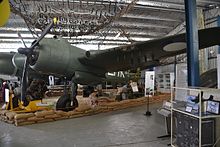


- Australia
- Beaufighter Mk.XXI A8–186 – Built in Australia in 1945, A8–186 saw service with No. 22 Squadron RAAF at the very end of World War 2. After spending some years on a farm in New South Wales, it was bought in 1965 by the Camden Museum of Aviation, a private aviation museum at Camden Airport, Sydney Australia. It was restored using parts gathered from a wide variety of sources and wears "Beau-gunsville" nose art. They also have a complete nose section that was found at a Sydney Railway workshops and acquired by the museum.[24]
- Beaufighter Mk.XXI A8–328 – This Australian–built aircraft is displayed at the Australian National Aviation Museum near Melbourne as A8-39/EH-K. Completed on the day the Pacific War ended, it saw post-war service as a target-tug.[25]
- Beaufighter Mk.XXI A8-386 – nose section only, displayed with "Harry's Baby" nose art.[26]
- United Kingdom
- Beaufighter TF.X, RD253 – Displayed at the Royal Air Force Museum in London, this aircraft flew with Portuguese Air Force as BF-13 in the late 1940s. It was used as an instructional airframe before its return to the UK in 1965. Restoration was completed in 1968, using components scavenged from a wide variety of sources, including some parts recovered from a crash site.[27]
- Beaufighter TF.X RD220 – This aircraft is currently displayed while under restoration at the National Museum of Flight at East Fortune Airfield, east of Edinburgh. Post-war, it served with the Portuguese naval air arm. After passing through the hands of the Portuguese Museu do Ar and the South African Air Force Museum, it was acquired by National Museums Scotland in 2000.[28]
- United States
- Beaufighter Mk Ic A19-43[29] – On public display at the National Museum of the United States Air Force, Dayton, Ohio since October 2006. Although flown in combat in the south-west Pacific by 31 Squadron Royal Australian Air Force, A19-43 is painted as T5049, Night Mare, a USAAF Beaufighter flown by Capt. Harold Augspurger, commander of the 415th Night Fighter Squadron, who shot down a Heinkel He 111 carrying German staff officers in September 1944. The Beaufighter was recovered from a dump at Nhill, Australia, in 1971, where it had been abandoned in 1947. It was acquired by the USAF Museum in 1988.[30]
Under restoration/stored
- Beaufighter TF.X RD867 – Under storage at Canada Aviation Museum, RD867 awaits restoration. It is a semi-complete RAF restoration but lacks engines, cowlings or internal components. It was received from the RAF Museum in exchange for a Bristol Bolingbroke in 1969.
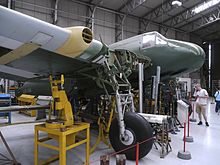
- Beaufighter Mk.Ic A19-144 – Owned by The Fighter Collection at Duxford, this aircraft has been undergoing a lengthy restoration to flying status for some years. It is a composite aircraft built using parts from JM135/A19-144 and JL946/A19-148.[31]
A number of sunken aircraft are known; in 2005, the wreck of a Beaufighter (probably a Mk.IC flown by Sgt Donald Frazie and navigator Sgt Sandery of No. 272 Squadron RAF) was identified about 0.5-mile (0.80 km) off the north coast of Malta. The aircraft ditched in March 1943, after an engine failure occurred soon after take-off and lies inverted on the sea bed, in 38 metres (125 ft) of water.[32]
Another Mediterranean wreck lies in 34 metres (112 ft) of water near the Greek island of Paros.[33] This is possibly Beaufighter TF.X LX998 of 603 Squadron, which was shot down after destroying a German Arado Ar 196 during an anti-shipping mission in November 1943, the Australian crew survived and were rescued by a British submarine.
A Mk.VIC Beaufighter, serial A19-130, lies in 204 feet (62 m) of water, just off the coast of Fergusson Island in the western Pacific. It was lost in almost identical circumstances to the Malta aircraft – it ditched in August 1943 after an engine failure soon after takeoff. The aircraft sank within seconds, but all three crew escaped and swam to shore. The wreck was located in 2000.[34]
The Midland Air Museum, Coventry, England has a Beaufighter cockpit section on public display. Its identity is thought possibly to be T5298.
Specifications (Beaufighter TF X)

Data from Jane's Fighting Aircraft of World War II[35]
General characteristics
- Crew: 2: pilot, observer
Performance
Armament
- Guns
- 4 × 20 mm Hispano Mk II cannon (240 rpg) in nose
- 1 × manually operated .303 in (7.7 mm) Browning for observer
- External loads
- 2× 250 lb bombs or
- 1× British 18 inch torpedo or
- 1× Mark 13 torpedo or
- 8 × RP-3 "60 lb" (27 kg) rockets (underwing)
See also
Related development
Aircraft of comparable role, configuration, and era
- Douglas A-20 Havoc
- Douglas A-26 Invader
- de Havilland Mosquito
- Northrop P-61 Black Widow
- Petlyakov Pe-3
- Heinkel He 219
- Kawasaki Ki-45
- I.Ae. 24 Calquin
Related lists
References
Notes
- ^ Ashworth 1992, p. 115.
- ^ Buttler p38
- ^ Buttler p40
- ^ with Hercules III engines
- ^ White (2006), p. 64
- ^ Bailey (2005), p. 114
- ^ Bristol Beaufighter VI squadron.com Template:Wayback
- ^ "Bristol Beaufighter - Variants and Stats". History of War. Retrieved 27 October 2015.
- ^ Its armament was exceeded by the gunship variants of the US North American B-25 Mitchell and Douglas A-26 Invader medium bombers
- ^ a b Bradley 2010, p. 20.
- ^ White (2006), p. 62-64
- ^ Franks 21002, p. 171.
- ^ Hall 1995, p. 24.
- ^ Bowyer 2010, p. 262.
- ^ "Bristol Beaufighter". Aviation History. Retrieved 27 October 2015.
- ^ Roba, 2009 p. 140.
- ^ Bowyer 1994, p. 90.
- ^ Browne, Anthony Montague, Long Sunset: Memoirs of Winston Churchill's Last Private Secretary London 1995 Chapter 3 ISBN 0304344788
- ^ Thetford, 1976. p.144
- ^ Buttler, Tony. Secret Projects: British Fighters and Bombers 1935–1950 (British Secret Projects 3). Leicester, UK: Midland Publishing, 2004. ISBN 1-85780-179-2.
- ^ Buttler p63
- ^ Franks 2002, pp. 65–67.
- ^ Franks 2002, pp. 70–72.
- ^ {"Beaufighter 156 Mk 21 A8-186." Camden Museum of Aviation. Retrieved: 27 March 2013.
- ^ "DAP Mark 21 Beaufighter, A8–328." Australian National Aviation Museum. Retrieved: 27 March 2013.
- ^ "Beaufighter/A8-386." beaufighterregistry. Retrieved: 3 April 2015.
- ^ Simpson, Andrew. "Individual History: Bristol Beaufighter TF Mk.X RD253/BF-13/7931M." Royal Air Force Museum. Retrieved: 27 March 2013.
- ^ "Bristol Beaufighter TF.X." National Museums Scotland. Retrieved: 27 March 2013.
- ^ "Bristol Beaufighter IC, A19-43 / T5049 / Night Mare, National Museum of the United States Air Force." Air-Britain Photographic Images Collection. Retrieved: 27 March 2013.
- ^ "Bristol Beaufighter Mark Ic Serial Number A19-43." Pacificwrecks.com, 26 July 2011. Retrieved: 28 March 2013.
- ^ "Beaufighter/JM135." warbirdregistry.org. Retrieved: 3 April 2015.
- ^ Trzcinski, Marcin. "On! On!." Diver, 2005. Retrieved: 3 April 2015.
- ^ "Beaufighter Wreck Paros." Paros Adventures. Retrieved: 28 March 2013.
- ^ "Bristol Beaufighter Mark VIc Serial Number A19-130." Pacificwrecks.com, 26 July 2011. Retrieved: 27 March 2013.
- ^ Bridgeman 1946, pp. 110–111.
- ^ March 1998, p. 57.
Bibliography
- Ashworth, Chris. RAF Coastal Command: 1936–1969. London: Patrick Stephens Ltd., 1992. ISBN 1-85260-345-3.
- Bailey, James Richard Abe (Jim). "The Sky Suspended". London: Bloomsbury, 2005. ISBN 0-7475-7773-0.
- Bingham, Victor. Bristol Beaufighter. Shrewsbury, UK: Airlife Publishing, Ltd., 1994. ISBN 1-85310-122-2.
- Bowyer, Chaz. Beaufighter. London: William Kimber, 1987. ISBN 0-7183-0647-3.
- Bowyer, Chaz. Beaufighter at War. London: Ian Allan Ltd., 1994. ISBN 0-7110-0704-7.
- Bowyer, Michael J. F. The Battle of Britain: The Fight for Survival in 1940. Manchester, UK: Crécy Publishing, 2010. ISBN 978-0-85979-147-2.
- Buttler, Tony. British Secret Projects — Fighters and Bombers 1935–1950. Hinckley, UK: Midland Publishing, 2004. ISBN 1-85780-179-2.
- Bridgeman, Leonard, ed. "The Bristol 156 Beaufighter." Jane's Fighting Aircraft of World War II. London: Studio, 1946. ISBN 1-85170-493-0.
- Flintham, V. Air Wars and Aircraft: A Detailed Record of Air Combat, 1945 to the Present. New York: Facts on File, 1990. ISBN 0-8160-2356-5.
- Franks, Richard A. The Bristol Beaufighter, a Comprehensive Guide for the Modeller. Bedford, UK: SAM Publications, 2002. ISBN 0-9533465-5-2.
- Gilman J.D. and J. Clive. KG 200 (novel). London: Pan Books Ltd., 1978. ISBN 978-1-902109-33-6.
- Hall, Alan W. Bristol Beaufighter (Warpaint No. 1). Dunstable, UK: Hall Park Books, 1995.
- Howard. "Bristol Beaufighter: The Inside Story". Scale Aircraft Modelling, Vol. 11, No. 10, July 1989.
- Innes, Davis J. Beaufighters over Burma – 27 Sqn RAF 1942–45. Poole, Dorset, UK: Blandford Press, 1985. ISBN 0-7137-1599-5.
- March, Daniel J., ed. British Warplanes of World War II. London: Aerospace Publishing, 1998. ISBN 1-874023-92-1.
- Mason, Francis K. Archive: Bristol Beaufighter. Oxford, UK: Container Publications.
- Moyes, Philip J.R. The Bristol Beaufighter I & II (Aircraft in Profile Number 137). Leatherhead, Surrey, UK: Profile Publications Ltd., 1966.
- Parry, Simon W. Beaufighter Squadrons in Focus. Walton on Thames, Surrey, Uk: Red Kite, 2001. ISBN 0-9538061-2-X.
- Roba, Jean Louis. Foreign Planes in the Service of the Luftwaffe. Pen & Sword Aviation, 2009. ISBN 1-84884-081-0.
- Scutts, Jerry. Bristol Beaufighter (Crowood Aviation Series). Ramsbury, Marlborough, Wiltshire, UK: The Crowood Press Ltd., 2004. ISBN 1-86126-666-9.
- Scutts, Jerry. Bristol Beaufighter in Action (Aircraft number 153). Carrollton, Texas: Squadron/Signal Publications, 1995. ISBN 0-89747-333-7.
- Spencer, Dennis A. Looking Backwards Over Burma: Wartime Recollections of a RAF Beaufighter Navigator. Bognor Regis, West Sussex, UK: Woodfield Publishing Ltd., 2009. ISBN 1-84683-073-7.
- Thetford,Owen. Aircraft of the Royal Air Force since 1918. London: Putnam & Company, 1976. ISBN 978-0-37010-056-2.
- Thomas, Andrew. Beaufighter Aces of World War 2. Botley, UK: Osprey Publishing, 2005. ISBN 1-84176-846-4.
- White, Graham. The Long Road to the Sky: Night Fighter Over Germany. Philadelphia, Pennsylvania: Casemate Publishers, 2006. ISBN 978-1-84415-471-5.
- Wilson, Stewart. Beaufort, Beaufighter and Mosquito in Australian Service. Weston, ACT, Australia: Aerospace Publications, 1990. ISBN 0-9587978-4-6.
Further reading
- Bradley, Phillip. To Salamaua. Cambridge, UK: Cambridge University Press, 2010. ISBN 978-1-107-27633-8.
External links
- Austin & Longbridge Aircraft Production
- A picture of a Merlin-engined Beaufighter II
- Bristol Beaufighter further information and pictures
- Beaufighter Squadrons[1]
- "Torpedo Beaufighter" a 1943 Flight article
- "Whispering Death" a 1945 Flight article on Beaufighters in Burma
- Beaufighter - Whispering Death, The Forgotten Warhorse - documentary on Beaufighters in Australian service
- "The Bismark Convoy Smashed !" Australian 1943 propaganda film about the destruction of a Japanese invasion convoy in the Bismark Sea filmed from a Beaufighter.
- Pilot's Notes
- ^ "Beaufighter - Whispering Death, The Forgotten Warhorse". You Tube GB. c4nucksens8tion. 16 Mar 2013. Retrieved 28 April 2016.
